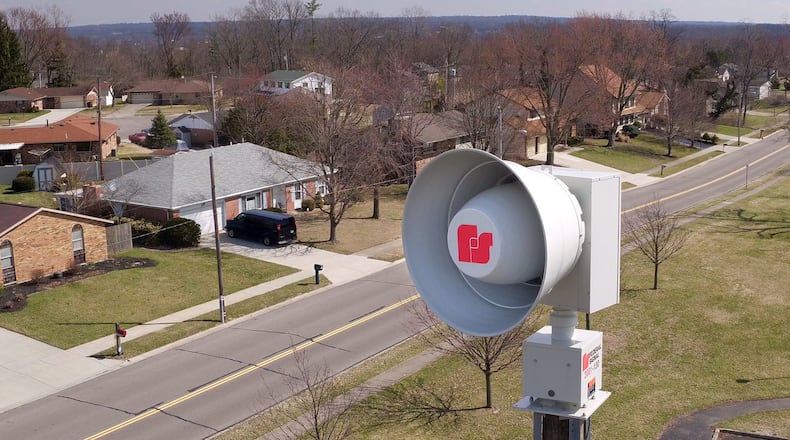While neither Ohio tornado this year caused loss of life, the deadly fury of two left 23 people dead in Lee County, Ala., earlier this month, illustrating the need to know where to quickly find shelter during a storm.
MORE: Photos show devastation of 1974 Xenia tornado
“Perhaps you don’t have a basement, but you have a bathroom in the center of your home or business. Think to yourself, would it be big enough to accommodate everyone? Is the bathtub large enough? If the answer is no, where would you go? These are the questions you would want to answer now, not when a tornado is barreling down on top of you,” said Storm Center 7 Chief Meteorologist McCall Vrydaghs.
This year’s Ohio drill comes during the state’s Severe Weather Awareness Week, just two weeks away from the 45th anniversary of the April 3, 1974, tornado that killed more than 33 people and injured more than 1,300. That outbreak churned 148 tornadoes in 13 states in the eastern United States.
For today’s statewide drill, all schools, citizens and businesses were encouraged to participate by reviewing and running through their action plan of what to do and where to go during severe weather.
RELATED: Vrydaghs: Severe weather season is here
“There are small, easy steps one can take right now to protect themselves and their loved ones,” wrote Jay Carey, of the Ohio Emergency Management Agency’s Committee for Severe Weather Awareness.
Taking shelter
The Ohio Committee for Severe Weather Awareness advises Ohioans to know the difference between a tornado watch and warning and in the event of a warning to DUCK.
A tornado watch means a tornado is possible. Stay tuned to your local radio station or television for weather updates. Know where you’ll shelter, if necessary. A tornado Warning means a tornado is happening or imminent and you should take shelter, or DUCK, immediately:
- Go DOWN to the lowest level
- Get UNDER something
- COVER your head
- KEEP in shelter until the storm has passed
West Carrollton received federal grant funding to purchase four new sirens in 2017. Thirteen other Montgomery County municipalities and townships as well as the University of Dayton took advantage of Homeland Security funds that defrayed half of the $20,250 cost of each siren.
“It’s like any type of protection, there are layers, and you can consider the siren as a layer of warning to the community,” said West Carrollton Fire Chief Chris Barnett.
Barnett said sirens are less effective for those inside or farther away from the towers, so he urges use of a NOAA weather radio or phone app for weather alerts.
The siren may be the first and best alert for those taking part in outdoor activities, he said.
“You may not have your cell phone handy or a NOAA weather radio, if these go off that’s a cue to get to an area where you can find out what is going on,” Barnett said.
The early March outbreak in Alabama accounted for all but one of the 24 tornado deaths so far this year, already more than double last year’s 10 fatalities. But despite the number of deaths, preliminary National Weather Service statistics show that between January and March, the number of tornadoes has been much lower than expected to reach the U.S. annual average of 1,253 tornadoes between 1991 - 2010.
Carey said steps beforehand like preparing emergency kits for homes and cars, having a family communication plan and staying informed and knowing the difference between watches and warnings can be the difference between life and death.
“Take these words, this knowledge, and actually do something with it,” he said.
Tornado Watch
A tornado watch outlines an area where conditions are favorable for the development of tornadoes in and close to the watch area.
Action: Review tornado safety rules and be prepared to move a place of safety if threatening weather approaches.
Tornado Warning
A tornado warning is issued when a tornado is imminent or occurring. The warning may be issued when a tornado is either indicated by Doppler radar or sighted by trained spotters.
Action: Seek shelter immediately, preferably below ground in a substantial building.
Tornado Emergency
An exceedingly rare tornado warning or statement issued when there is a severe threat to human life and catastrophic damage from an imminent or ongoing tornado. This tornado warning is reserved for situations when a reliable source confirms a tornado, or there is clear radar evidence of the existence of a strong, damaging tornado, such as the observation of debris.
Action: Seek shelter immediately, preferably below ground in a substantial building.
Source: Ohio Emergency Management Agency
DRILL TODAY
Sirens sounded at 9:50 a.m. today for Ohio’s annual tornado drill conducted by the Ohio Emergency Management Agency and National Weather Service. Local warning sirens, National Oceanic and Atmospheric Administration (NOAA) weather radios, and the Emergency Alert System were activated to signal the start of the drill.
About the Author

